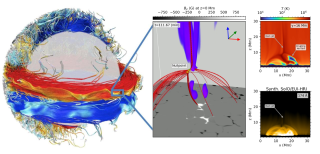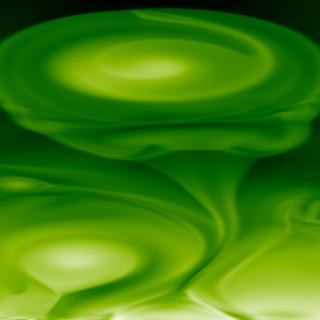Bibcode
Færder, Ø. H.; Nóbrega-Siverio, D.; Carlsson, M.
Bibliographical reference
Astronomy and Astrophysics
Advertised on:
3
2024
Journal
Citations
2
Refereed citations
2
Description
Context. Plasmoid-mediated reconnection plays a fundamental role in different solar atmospheric phenomena. Numerical reproduction of this process is therefore essential for developing robust solar models.
Aims: Our goal is to assess plasmoid-mediated reconnection across various numerical resistivity models in order to investigate how plasmoid numbers and reconnection rates depend on the Lundquist number.
Methods: We used the Bifrost code to drive magnetic reconnection in a 2D coronal fan-spine topology, carrying out a parametric study of several experiments with different numerical resolution and resistivity models. We employed three anomalous resistivity models: (1) the original hyper-diffusion from Bifrost, (2) a resistivity proportional to current density, and (3) a resistivity quadratically proportional to electron drift velocity. For comparisons, experiments with uniform resistivity were also run.
Results: Plasmoid-mediated reconnection is obtained in most of the experiments. With uniform resistivity, increasing the resolution reveals higher plasmoid frequency with weaker scaling to the Lundquist number, obtaining 7.9-12 plasmoids per minute for SL ∈ [1.8 × 104, 2.6 × 105] with a scaling of SL0.210 in the highest-resolution resistivity cases, transcending into Petschek reconnection in the high-SL limit (where the diffusive effects of the resistivity become small compared to the non-uniform viscosity) and Sweet-Parker reconnection in the low-SL limit. Anomalous resistivity leads to similar results even with lower resolution. The drift-velocity-dependent resistivity excellently reproduces Petschek reconnection for any Lundquist number, and similar results are seen with resistivity proportional to current-density though with slightly lower reconnection rates and plasmoid numbers. Among the different resistivity models applied on the given numerical resolution, the hyper-diffusion model reproduced plasmoid characteristics in closest resemblance to those obtained with uniform resistivity at a significantly higher resolution.
Aims: Our goal is to assess plasmoid-mediated reconnection across various numerical resistivity models in order to investigate how plasmoid numbers and reconnection rates depend on the Lundquist number.
Methods: We used the Bifrost code to drive magnetic reconnection in a 2D coronal fan-spine topology, carrying out a parametric study of several experiments with different numerical resolution and resistivity models. We employed three anomalous resistivity models: (1) the original hyper-diffusion from Bifrost, (2) a resistivity proportional to current density, and (3) a resistivity quadratically proportional to electron drift velocity. For comparisons, experiments with uniform resistivity were also run.
Results: Plasmoid-mediated reconnection is obtained in most of the experiments. With uniform resistivity, increasing the resolution reveals higher plasmoid frequency with weaker scaling to the Lundquist number, obtaining 7.9-12 plasmoids per minute for SL ∈ [1.8 × 104, 2.6 × 105] with a scaling of SL0.210 in the highest-resolution resistivity cases, transcending into Petschek reconnection in the high-SL limit (where the diffusive effects of the resistivity become small compared to the non-uniform viscosity) and Sweet-Parker reconnection in the low-SL limit. Anomalous resistivity leads to similar results even with lower resolution. The drift-velocity-dependent resistivity excellently reproduces Petschek reconnection for any Lundquist number, and similar results are seen with resistivity proportional to current-density though with slightly lower reconnection rates and plasmoid numbers. Among the different resistivity models applied on the given numerical resolution, the hyper-diffusion model reproduced plasmoid characteristics in closest resemblance to those obtained with uniform resistivity at a significantly higher resolution.
Movies are available at https://www.aanda.org.
Related projects

The Whole Sun Project: Untangling the complex physical mechanisms behind our eruptive star and its twins
The Sun is a magnetically active star with violent eruptions that can hit Earth´s magnetosphere and cause important perturbations in our technology-dependent society. The objective of the Whole Sun project is to tackle in a coherent way for the first time key questions in Solar Physics that involve as a whole the solar interior and the atmosphere
Fernando
Moreno Insertis

Numerical Simulation of Astrophysical Processes
Numerical simulation through complex computer codes has been a fundamental tool in physics and technology research for decades. The rapid growth of computing capabilities, coupled with significant advances in numerical mathematics, has made this branch of research accessible to medium-sized research centers, bridging the gap between theoretical and
Daniel Elías
Nóbrega Siverio